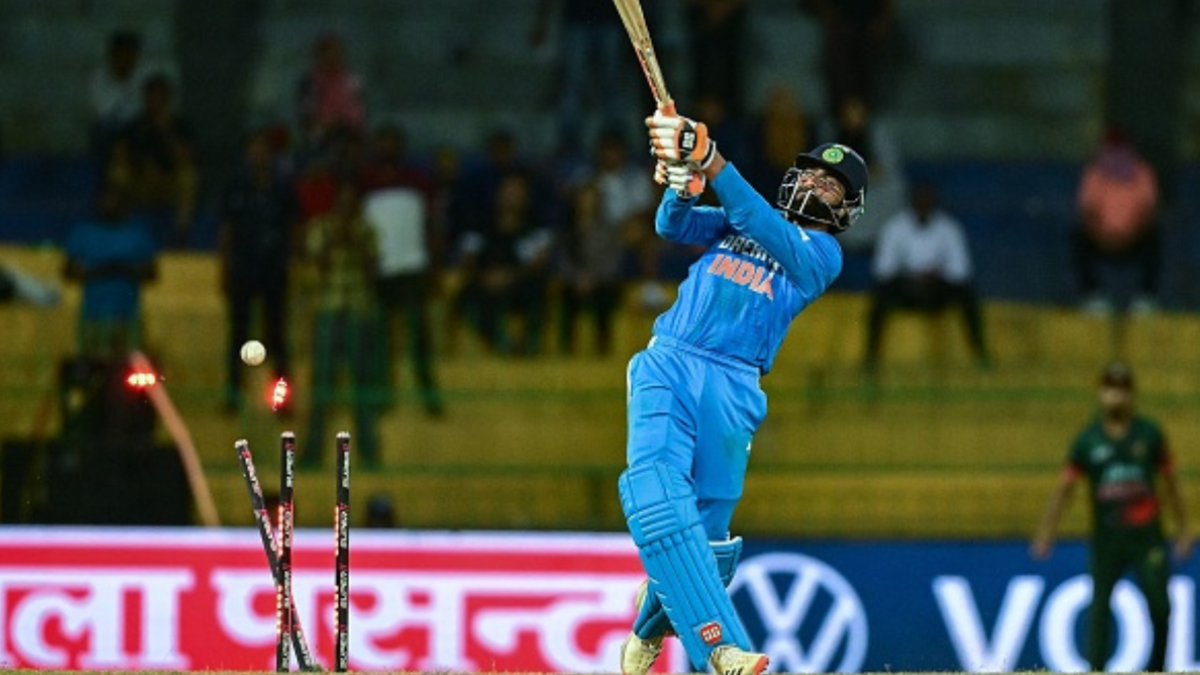
Ravindra Jadeja’s batting form remains a worry for India heading into the World Cup, which threatens to disrupt their balance and combinations in the event, writes Sarah Waris.
To bet on the World Cup with our Match Centre Partners bet365 head here.
Jadeja walked out to bat at 233-5 in the third Australia ODI when the game was all but over for the hosts. Needing 120 more in 76 deliveries, Jadeja started off with two fours but, instead of carrying on in the same vein he went into a shell, making five more runs in the next 11 deliveries.
A number of times, Jadeja looked to make room, but he failed to get power behind his shots. When he did, he more often than not found a fielder. Towards the end of the innings, Jadeja was content running the odd single, and though he eventually finished with a 36-ball 35, the intent was lacking.
Having struggled for runs this year, Jadeja had the opportunity to attack more at Rajkot and make the most of the situation with nothing to lose. A few big blows would have boosted his and the team’s confidence heading into the World Cup, but his failure to do so means they now enter the event with No.7 still in scratchy form.
Since the start of 2023, Jadeja has batted in 12 innings, scoring 189 runs at an average of 27. He has not made a half-century once in that time, and while batting down the order alleviates the issue, his strike rate of 64.28 is a bigger worry. Before Wednesday, he had not hit a single six in an ODI innings this year, which hints at his declining power hitting skills. In contrast, he smashed 12 sixes in as many innings from the start of the 2019 World Cup till the end of 2020 when he averaged 62.66 with a strike rate of 106.51. It was arguably his best batting phase in ODI cricket.
Among batters from Test-playing nation who have faced at least 260 deliveries in 50-over cricket this year, Jadeja’s strike rate is the worst. The India batter with the second-worst strike rate in this period with similar filters is KL Rahul with a strike rate of 86.90 – a difference of approximately 27 runs.
Jadeja also has the the second-worst strike rate (63.36) among all players who have played out at least 250 balls at No.7 or below this year, and it has affected how India finish off their innings in ODIs.
Yesterday was the first time that Ravindra Jadeja hit a six in ODIs in 2023. #CWC23 pic.twitter.com/a2wUQwNtkJ
— Wisden India (@WisdenIndia) September 28, 2023
In the first 15 overs in ODIs this year, India have a strike rate of 96.41, the second-best in the world. Skipper Rohit Sharma has been vocal in increasing the scoring rate, and he has led from the front, scoring over 112 runs for every 100 balls that he faces. Between overs 16-35, India’s strike rate falls to 88.11, largely due to the struggles of the batters against spin. But due to the blazing start, they are often ahead of the curve before the last 15 overs.
India have a collective strike rate of 113.92 between overs 36-40, but it takes a beating when Jadeja bats. He has a strike rate of 74.3 in the death, faces 53.4 percentage of dot balls and has ended with a strike rate below 65 in five of the nine innings in that phase this year.
An in-form Jadeja could have solved a number of issues for India. Being the only left-hander in the top seven, if India play Shreyas Iyer, he could have been used as a floater according to different match-ups. If he was in prime hitting form, India could also have had the option of fielding three quicks in Mohammed Shami, Mohammed Siraj and Jasprit Bumrah in their XI.
They are instead forced to increase their batting depth and have Shardul Thakur as their third seamer while a modern-day great ODI bowler Shami, who has a batting average of 8.40 in ODIs, sits out.
Jadeja’s bowling remains handy and he has been economical, allowing Thakur to thrive in the middle overs due to the pressure that he creates, but that is not the only reason he is in the team. He lends balance to the team, and is the only batter who regularly sends down ten overs as well, with Pandya’s contributions depending on fitness and the performances of the other quicks.
Dropping him would further increase India’s worries, with R Ashwin, the latest addition in the squad, or Thakur, not giving enough confidence to be at No.7. India have the option of playing someone like Suryakumar Yadav as the finisher, with Hardik as the fifth bowler, but is is a move that does not instill confidence given Hardik’s recent role.
Jadeja keeps the line-up glued together, but that is not the only reason why India have picked him.








